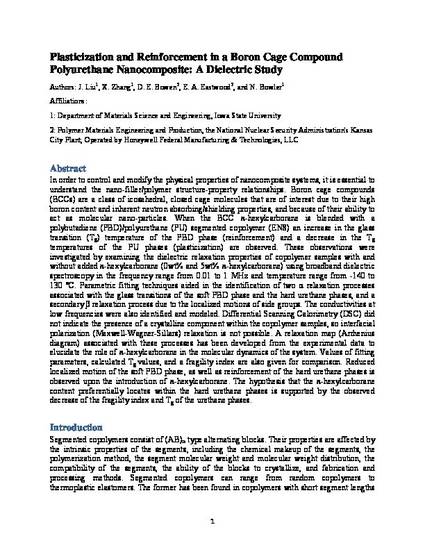
In order to control and modify the physical properties of nanocomposite systems, it is essential to understand the nano-filler/polymer structure–property relationships. Boron cage compounds (BCCs) are a class of icosahedral, closed cage molecules that are of interest due to their high boron content, their inherent neutron absorbing/shielding properties, their potential ability to act as molecular nano-particles and their ability to significantly improve the thermal stability of polymers in which they have been incorporated. When the BCC n-hexylcarborane is blended with a polybutadiene (PBD)/polyurethane (PU) segmented copolymer (EN8) an increase in the glass transition (Tg) temperature of the PBD phase (reinforcement) and a decrease in the Tg temperatures of the PU phases (plasticization) are observed. These observations were investigated by examining the dielectric relaxation properties of copolymer samples with and without added n-hexylcarborane (0 wt.% and 5 wt.% n-hexylcarborane) using broadband dielectric spectroscopy in the frequency range from 0.01 Hz to 1 MHz and temperature range from − 140 to 130 °C. Parametric fitting techniques aided in the identification of two α relaxation processes associated with the glass transitions of the soft PBD phase and the hard urethane phases, and a secondary βrelaxation process due to the localized motions of side groups. The conductivities at low frequencies were also identified and modeled. Differential Scanning Calorimetry (DSC) did not indicate the presence of a crystalline component within the copolymer samples, so interfacial polarization (Maxwell–Wagner–Sillars) relaxation is not possible. A relaxation map (Arrhenius diagram) associated with these processes has been developed from the experimental data to elucidate the role of n-hexylcarborane in the molecular dynamics of the system. Values of fitting parameters, calculated Tg values, and a fragility index are also given for comparison. Reduced localized motion of the soft PBD phase, as well as reinforcement of the hard urethane phases is observed upon the introduction of n-hexylcarborane. The hypothesis that the n-hexylcarborane content preferentially locates within the hard urethane phases is supported by the observed decrease of the fragility index and Tg of the urethane phases.
Available at: http://works.bepress.com/nicola_bowler/29/

This is a manuscript of an article published as Bowen, Dan, J. Liu, X. Zhang, E. Eastwood, and N. Bowler. Plasticization and Reinforcement in a Boron Cage Compound Polyurethane Nanocomposite: A Dielectric Study. No. KCP-613-9227. Kansas City Plant (KCP), Kansas City, MO (United States), 2012, doi:10.1016/j.jnoncrysol.2013.03.030. Posted with permission.